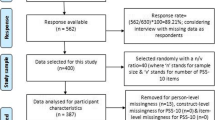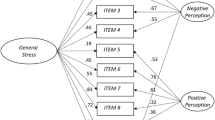Abstract
Valid psychological measures of stress are essential for the detection, management and prevention of stress and related mental illnesses. In this study the factorial structure, measurement invariance (gender and race), and reliability of the Perceived Stress Scale (PSS-10) were evaluated in a sample of university students (N = 862). Five competing measurement models of the PSS-10 (i.e., one-factor; correlated two-factor; bifactor with two domain specific factors; a bifactor, with the perceived self-efficacy factor; and a bifactor model, with the distress factor) were examined using confirmatory factor analysis and cross-validated using Rasch analysis. The two-factor model prevailed over the alternative latent structures, was invariant across gender and race groups, and had acceptable internal consistency reliability. This study supports the validity of the PSS-10 for use with diverse student populations.
Similar content being viewed by others
References
Baik, S. H., Fox, R. S., Mills, S. D., Roesch, S. C., Sadler, G. R., Klonoff, E. A., & Malcarne, V. L. (2019). Reliability and validity of the perceived stress scale-10 in Hispanic Americans with english or Spanish language preference. Journal of Health Psychology, 24(5), 628–639. https://doi.org/10.1177/1359105316684938.
Bantjes, J. R., Kagee, A., McGowan, T., & Steel, H. (2016). Symptoms of posttraumatic stress, depression, and anxiety as predictors of suicidal ideation among South African university students. Journal of American College Health, 64(6), 429–437. https://doi.org/10.1080/07448481.2016.1178120.
Barbosa-Leiker, C., Kostick, M., Lei, M., McPherson, S., Roper, V., Hoekstra, V., & Wright, B. (2013). Measurement invariance of the perceived stress scale and latent mean differences across gender and time. Stress and Health, 29(3), 253–260. https://doi.org/10.1002/smi.2463.
Bradbury, J. (2013). Modelling stress constructs with biomarkers: The importance of the measurement model. Clinical and Experimental Medical Sciences, 1(5–8), 197–216. https://doi.org/10.12988/cems.2013.13017.
Burnham, K. P., & Anderson, D. R. (2004). Multimodel inferences understanding AIC and BIC in model selection. Sociological Methods & Research, 33, 261–304.
Cohen, S. (1994). Perceived stress scale. Palo Alto: Mind Garden.
Cohen, S., & Williamson, G. (1988). Perceived stress in a probability sample of the U.S. In S. Spacapan & S. Oskamp (Eds.), The social psychology of health (pp. 31–67). Thousand Oaks: Sage.
Cohen, S., Kamarck, T., & Mermelstein, R. (1983). A global measure of perceived stress. Journal of Health and Social Behavior, 24, 385–396.
Dao-Tran, T., Anderson, D., & Seib, C. (2017). The Vietnamese version of the perceived stress scale (PSS-10): Translation equivalence and psychometric properties among older women. BMC Psychiatry, 17(53), 1–7.
Denovan, A., Dagnall, N., Dhingra, K., & Grogan, S. (2017). Evaluating the perceived stress scale among UK university students: Implications for stress measurement and management. Studies in Higher Education, 44, 120–133. https://doi.org/10.1080/03075079.2017.1340445.
Dougherty, B. E., Cooley, S. L., & Davidorf, F. H. (2017). Measurement of perceived stress in age-related macular degeneration. Optometry and Vision Science, 94(3), 290–296. https://doi.org/10.1097/OPX.0000000000001055.
Dunn, T. J., Baguley, T., & Brunsden, V. (2014). From alpha to omega: A practical solution to the pervasive problem of internal consistency estimation. British Journal of Psychology, 105(3), 339–412. https://doi.org/10.1111/bjop.12046.
Gitchel, W. D., Roessler, R. T., & Turner, R. C. (2011). Gender effect according to item directionality on the perceived stress scale for adults with multiple sclerosis. Rehabilitation Counselling Bulletin, 55(1), 20–28. https://doi.org/10.1177/0034355211404567.
Hong, G. R., Kang, H. K., Oh, E., Park, Y., & Kim, H. (2016). Reliability and validity of the Korean version of the perceived stress Scale-10 (K-PSS-10) in older adults. Research in Gerontological Nursing, 9(1), 45–51. https://doi.org/10.3928/19404921-20150806-72.
Kaya, C., Tansey, T. N., Melekoglu, M., Cakiroglu, O., & Chan, F. (2017). Psychometric evaluation of Turkish version of the perceived stress scale with Turkish college students. Journal of Mental Health, 20, 1–7. https://doi.org/10.1080/09638237.2017.1417566.
Khalili, R., Sirati Nir, M., Ebadi, A., Tavallai, A., & Habibi, M. (2017). Validity and reliability of the Cohen 10-item perceived stress scale in patients with chronic headache: Persian version. Asian Journal of Psychiatry, 26, 136–140. https://doi.org/10.1016/j.ajp.2017.01.010.
Lavoie, J. A. A., & Douglas, K. S. (2012). The Perceived Stress Scale: Evaluating configural, metric, and scalar invariance across mental health status and gender. Journal of Psychopathology and Behavioral Assessment, 34, 48–57. https://doi.org/10.1007/s10862-011-9266-1.
Lazarus, R. S., & Folkman, S. (1984). Stress, appraisal and coping. New York: Springer.
Lee, E. H. (2012). Review of the psychometric evidence of the perceived stress scale. Asian Nursing Research, 6, 121–127.
Lee, B., & Jeong, H. I. (2019). Construct validity of the perceived stress scale (PSS-10) in a sample of early childhood teacher candidates. Psychiatry and Clinical Psychopharmacology, 29(1), 76–82.
Linacre, J. M. (2009). A user’s guide to WINSTEPS. Chicago, IL: Winsteps.
Magalhaes Das Neves, M. K., Loots, J. K., & van Niekerk, R. L. (2014). The effect of various physical exercise modes on perceived psychological stress. South African Journal of Science, 26(4), 104–108. https://doi.org/10.7196/SAJSM.476.
Manzar, M. D., Salahuddin, M., Peter, S., Alghadir, A., Anwer, S., Bahammam, A. S., & Pandi-Perumal, S. R. (2019). Psychometric properties of the perceived stress scale in Ethiopian university students. BMC Public Health, 19, 41. https://doi.org/10.1186/s12889-018-6310-z.
Michaelides, M. P., Christodouloua, A., Kkelia, N., Kareklaa, M., & Panayiotou, G. (2016). Factorial structure of the perceived stress scale and implications for scoring. Revue européenne de psychologie appliquée, 66, 309–316.
Mondo, M., Sechi, C., & Cabras, C. (2019). Psychometric evaluation of three versions of the Italian perceived stress scale. Current Psychology. https://doi.org/10.1007/s12144-019-0132-8.
Nielsen, M. G., Ørnbøl, E., Vestergaard, M., Bech, P., Larsen, F. B., Lasgaard, M., & Christensen, K. S. (2016). The construct validity of the perceived stress scale. Journal of Psychosomatic Research, 84, 22–30. https://doi.org/10.1016/j.jpsychores.2016.03.009.
Pereira-Morales, A. J., Adan, A., & Forero, D. A. (2019). Perceived stress as a mediator of the relationship between neuroticism and depression and anxiety symptoms. Current Psychology, 38, 66–74. https://doi.org/10.1007/s12144-017-9587-7.
Perera, M. J., Brintz, C. J., Birnbaum-Weitzman, O., Penedo, F. J., Gallo, L. C., Gonzalez, P., Gouskova, N., Isasi, C. R., Navas-Nacher, E. L., Perreira, K. M., Roesch, S. C., Schneiderman, N., & Llabre, M. M. (2017). Factor structure of the perceived stress scale-10 (PSS) across English and Spanish language responders in the HCHS/SOL sociocultural ancillary study. Psychological Assessment, 29(3), 320–328. https://doi.org/10.1037/pas0000336.
Ramırez, M., Ford, M. E., Stewart, A. L., & Teresi, J. A. (2005). Measurement issues in health disparities research. Health Services Research, 40(5), 1640–1657. https://doi.org/10.1111/j.1475-6773.2005.00450.x.
Reis, R. S., Hino, A. A. F., & Rodriguez-Anez, C. R. (2010). Perceived stress scale: Reliability and validity study in Brazil. Journal of Health Psychology, 15(1), 107–114. https://doi.org/10.1177/1359105309346343.
Reise, S. P., Morizot, J., & Hays, R. D. (2007). The role of the Bifactor model in resolving dimensionality issues in health outcomes measures. Quality of Life Research, 16(1), 19–31. https://doi.org/10.1007/s11136-007-9183-7.
Scott, N. W., Fayers, P. M., Aaronson, N. K., Bottomley, A., De Graeff, A., & Groenvold, M. (2009). A simulation study provided sample size guidance for differential item functioning (DIF) studies using short scales. Journal of Clinical Epidemiology, 62, 288–295. https://doi.org/10.1016/j.jclinepi.2008.06.003.
Smith, K. J., D. L. Rosenberg, & Haight, G. T. (2014). An assessment of the psychometric properties of the perceived Stress Scale-10 (PSS10) with business and accounting students. Accounting Perspectives, 13(1), 29–59. https://doi.org/10.1111/1911-3838.1202.
Taylor, J. M. (2015). Psychometric analysis of the ten-item Perceived Stress Scale. Psychological Assessment, 27(1), 90–101. https://doi.org/10.1037/a0038100.
Tennant, A., & Conaghan, P. G. (2007). The Rasch measurement model in rheumatology: what is it and why use it? When should it be applied, and what should one look for in a Rasch paper? Arthritis and Rheumatism, 57(8), 1358–1362.
van Zyl, P. M., Joubert, G., Bowen, E., du Plooy, F., Francis, C., Jadhunandan, S., Fredericks, F., & Metz, L. (2017). Depression, anxiety, stress and substance abuse in medical students in a 5-year curriculum. African Journal of Health Professions Education, 9(2), 67–72.
Zajenkowska, A., Jasielska, D., & Melonowska, J. (2019). Stress and sensitivity to frustration predicting depression among young adults in Poland and Korea: Psychological and philosophical explanations. Current Psychology, 38, 769–774. https://doi.org/10.1007/s12144-017-9654-0.
Zhang, B., Zhao, F., Yan, X., & Yuan, F. (2015). The relationship between perceived stress and adolescent depression: The roles of social support and gender. Social Indicators Research, 123(2), 501–518. https://doi.org/10.1007/s11205-0140739-y.
Author information
Authors and Affiliations
Corresponding author
Ethics declarations
All procedures performed in the study were in accordance with the ethical standards of the Ethics Committees of both the University of Pretoria and the University of Limpopo and with the 1964 Helsinki Declaration and its later amendments or comparable ethical standards.
Conflict of Interest
The authors declare that they have no conflict of interest.
Informed Consent
Informed consent was obtained from all the participants of the study.
Declaration
The manuscript has not been published previously and is not under simultaneous review elsewhere.
Confirmation of access to the original data
The author confirms that he has access to the original data on which the article reports.
Additional information
Publisher’s Note
Springer Nature remains neutral with regard to jurisdictional claims in published maps and institutional affiliations.
Rights and permissions
About this article
Cite this article
Makhubela, M. Assessing psychological stress in South African university students: Measurement validity of the perceived stress scale (PSS-10) in diverse populations. Curr Psychol 41, 2802–2809 (2022). https://doi.org/10.1007/s12144-020-00784-3
Published:
Issue Date:
DOI: https://doi.org/10.1007/s12144-020-00784-3




